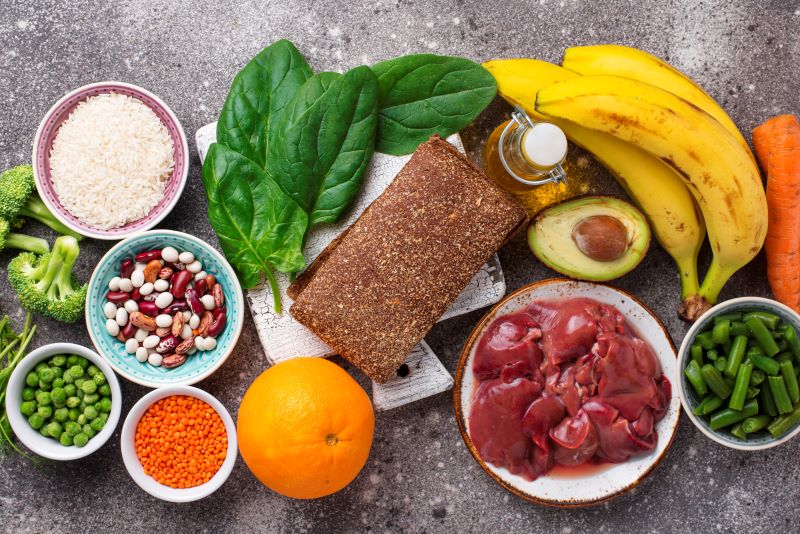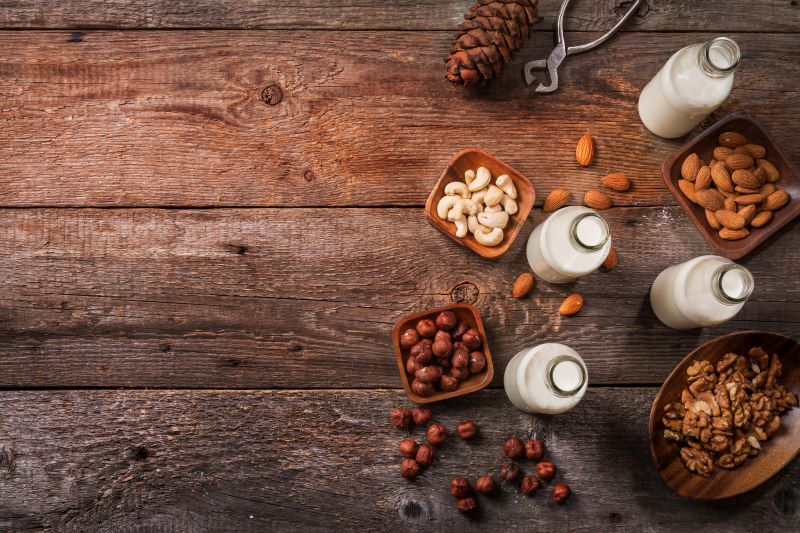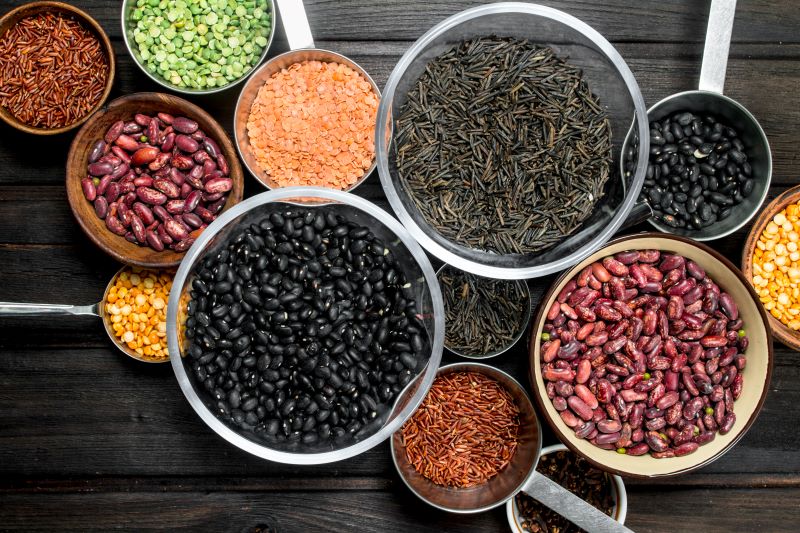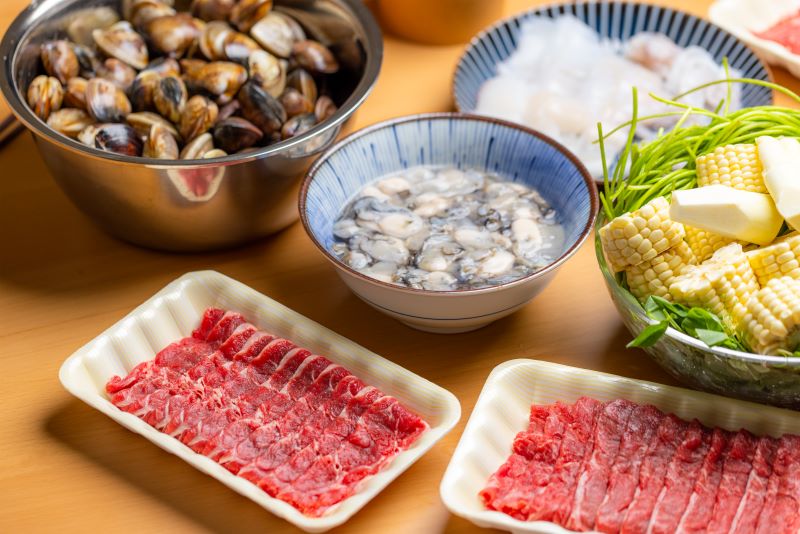43 Best Foods for Low Blood Pressure for Faster Recovery

We must maintain our blood pressure at the most favourable levels for the general welfare. But while so much attention has been paid to hypertension, low blood pressure or hypotension can also be dangerous and cause dizziness or tiredness.
Eating foods with many nutrients is a good way to manage it and recover quickly. This article will discuss some of the best foods for low blood pressure, which can help them gain strength on their journey towards better health.

Table of Contents

What is Low Blood Pressure?
Hypotension, otherwise known as low blood pressure, is a condition where the power of your blood against the walls is too weak to push sufficient oxygen and nutrients through vital organs. This may be indicated by symptoms such as dizziness (vertigo), fainting (syncope) or passing out, blurred vision, tiredness and sickness.
Unlike hypertension or high blood pressure, which are considered more dangerous, severe cases can have serious consequences, especially if they stay untreated over long periods. Because it decreases blood flow to brain cells that must have a continuous supply of oxygenated blood, or else they die within minutes, leading to irreparable damage.
43 Best Foods for Low Blood Pressure
To stay healthy and look after blood pressure, it is important to have a balanced diet. Low blood pressure can also be dangerous and uncomfortable.
Luckily there are certain meals rich in vitamin B12 and folates that can raise your BP as well as relieve symptoms associated with low levels of it. If added to the daily menu, these foods will contribute towards a steady blood flow throughout the body, thus promoting good health in general.
List of Folate Rich Vegetables for Low Blood Pressure
Vegetables supply a good amount of folic acid, without which one cannot control hypotension conditions effectively; therefore, including these nutrient-dense veggies in a daily ration might help target the stabilisation of BP levels.
SNo. |
Vegetables | Description | Folate Content (per 100g) |
| 1 | Spinach | With help in DNA synthesis and the formation of red blood cells, spinach has lots of folate. | Folate: 194 mcg |
| 2 | Kale | Folate rich kale provides nutrients for a healthy heart and other essential elements supporting overall health. | Folate: 141 mcg |
| 3 | Broccoli | To promote general well-being, broccoli contains reasonable amounts of folate. | Folate: 63 mcg |
| 4 | Brussels Sprouts | These versatile vegetables can be added to any dish and are a good source of folate, which supports red blood cell production. | Folate: 61 mcg |
| 5 | Asparagus | Asparagus supports nerve functions due to its high folate content, promoting cardiovascular health. | Folate: 149 mcg |
| 6 | Beetroot | For overall health benefits, beetroot supplies antioxidants and the necessary red blood cell-producing components such as folates. | Folate: 109 mcg |
| 7 | Carrots | Carrots contain carotenes needed for eye care and immune system enhancement, and they also contain ample supplies of the body's required folic acid. | Folate: 19 mcg |
| 8 | Cauliflower | Containing folic acid and being used in many different dishes makes cauliflower one versatile vegetable an option among others available today on the market shelves too! | Folate: 57 mcg |
| 9 | Bell Peppers | Bell peppers contain vitamin C to support immunity levels alongside healthy skin. | Folate: 23 mcg |
| 10 | Sweet Potatoes | Sweet potatoes provide folate and are a good source of fibre and antioxidants for overall health. | Folate: 11 mcg |
List of Fruits for Low Blood Pressure

Folate can also be found in fruits and juices that are tasty and beneficial for health. So when dealing with low pressure, we can eat these things because they provide the necessary elements to aid us in controlling this condition.
SNo. |
Fruits | Description | Folate Content (Per 100g) |
| 11 | Oranges | Oranges are rich in folate and vitamin C, supporting immune function and cardiovascular health. | Folate: 30 mcg |
| 12 | Papayas | Papayas provide folate and vitamin C, promoting digestive health and supporting immune function. | Folate: 37 mcg |
| 13 | Avocado | Avocado contains moderate folate and healthy fats, promoting heart health and energy. | Folate: 81 mcg |
| 14 | Guava | Guava is a good source of folate and vitamin C, supporting immune function and overall health. | Folate: 49 mcg |
| 15 | Strawberries | Strawberries offer folate and vitamin C, promoting heart health and providing antioxidants. | Folate: 24 mcg |
| 16 | Kiwi | Kiwi provides folate and vitamin C, supporting immune function and digestive health. | Folate: 25 mcg |
| 17 | Pineapple | Pineapple is a good folate and vitamin C source, aiding digestion and supporting immune function. | Folate: 18 mcg |
| 18 | Mango | Mango offers folate and vitamin C, supporting eye health and providing antioxidants. | Folate: 43 mcg |
List of Dairy Products and Nuts for Low Blood Pressure

Many dairy products contain high amounts of vitamin B12 and folic acid content, thus helping maintain normal BP levels throughout the day, especially during meals.
| SNo. | Dairy Products and Nuts | Description | Vit B12 and Folate Content (per 100g) |
| 19 | Yoghurt | Yoghurt is a rich source of vitamin B12 and provides probiotics, promoting gut health and aiding digestion. | Vitamin B12: 0.4 mcg, Folate: 13 mcg |
| 20 | Cottage Cheese | Cottage cheese contains vitamin B12 and is a good source of protein, supporting muscle health and providing satiety. | Vitamin B12: 0.3 mcg, Folate: 8 mcg |
| 21 | Milk (Whole, Skim, or Low-fat) | Milk is fortified with vitamin B12 and provides calcium for bone health, making it an essential part of a balanced diet. | Vitamin B12: 0.4 mcg, Folate: 5 mcg |
| 22 | Cheese (Cheddar, Swiss, etc.) | Cheese offers vitamin B12 and is a good source of calcium and protein, supporting bone health and providing essential nutrients. | Vitamin B12: 0.8 mcg, Folate: 18 mcg |
| 23 | Almonds | Almonds are a good source of vitamin B12 and folate, providing healthy fats and antioxidants for heart health. | Folate: 60 mcg |
| 24 | Walnuts | Walnuts contain moderate vitamin B12, folate, and omega-3 fatty acids, supporting brain and heart health. | Vitamin B12: 0.0 mcg; Folate: 98 mcg |
| 25 | Brazil Nuts | Brazil nuts offer vitamin B12, folate, and selenium, supporting thyroid function and immune health. | Vitamin B12: 0.0 mcg; Folate: 22 mcg |
| 26 | Hazelnuts | Hazelnuts provide vitamin B12, folate, healthy fats, and antioxidants, supporting heart health. | Vitamin B12: 0.0 mcg; Folate: 113 mcg |
| 27 | Pecans | Pecans offer vitamin B12, folate, and fibre, promoting digestive health and satiety. | Vitamin B12: 0.0 mcg; Folate: 22 mcg |
| 28 | Cashews | Cashews contain vitamin B12 and folate, providing essential nutrients for energy production and immune function. | Vitamin B12: 0.0 mcg; Folate: 25 mcg |
List of Vitamin B12 and Folate Rich Vegetarian Foods for Low Blood Pressure

Vegetarian diets are a good source of vitamin B12 and folate, which are important in treating hypotension. These are some examples of plant-based products you can eat to meet your nutritional needs and maintain general health.
| SNo. | Foods | Description | Vit B12 and Folate Content (per 100g) |
| 29 | Fortified Nutritional Yeast | Nutritional yeast is a staple for vegetarians, offering vitamin B12 and a cheesy flavour, perfect for sprinkling on dishes or mixing into sauces. | Vitamin B12: 3.3 mcg (138% DV); Folate: 107 mcg |
| 30 | Tempeh | Tempeh is a fermented soy product rich in folate, providing a meaty texture and protein, suitable for various savoury dishes. | Vitamin B12: 0.0 mcg; Folate: 62 mcg |
| 31 | Tofu | Tofu is a versatile plant-based protein source that can be marinated, grilled, or added to stir-fries, offering folate. | Vitamin B12: 0.0 mcg; Folate: 93 mcg |
| 32 | Lentils | Lentils are a nutritious legume high in folate and protein, perfect for soups, salads, or veggie burgers, providing essential nutrients. | Vitamin B12: 0.0 mcg; Folate: 181 mcg |
| 33 | Chickpeas | Chickpeas, also known as garbanzo beans, are packed with folate and protein, ideal for making hummus, curries, or roasted snacks. | Vitamin B12: 0.0 mcg; Folate: 172 mcg |
| 34 | Kidney Beans | Kidney beans offer folate and protein, making them a hearty addition to chili, salads, or bean-based dishes. They also provide essential nutrients. | Vitamin B12: 0.0 mcg; Folate: 44 mcg |
List of Non-Vegetarian Foods for Low Blood Pressure

If you have low BP, non-veg food contains vitamin B12 and folic acid, which are essential for it. So consider this list when planning your meals to get enough nutrients your body requires while keeping fit.
| SNo. | Foods | Description | Vit B12 and Folate Content (Per 100g) |
| 35 | Beef Liver | Beef liver is a powerhouse of vitamin B12, essential for energy production and neurological health, making it a nutrient-dense choice. | Vitamin B12: 111.3 mcg, Folate: 0.5 mcg |
| 36 | Clams | Clams are rich in vitamin B12 and offer a good source of protein, perfect for seafood lovers, and provide essential nutrients. | Vitamin B12: 98.9 mcg, Folate: 45.7 mcg |
| 37 | Oysters | Oysters are high in vitamin B12 and offer a dose of zinc, which supports immune function and provides essential nutrients for overall health. | Vitamin B12: 24.1 mcg, Folate: 6 mcg |
| 38 | Salmon | Salmon provides vitamin B12 and omega-3 fatty acids, supporting heart health and offering a flavourful addition to any diet. | Vitamin B12: 4.9 mcg Folate: 1.5 mcg |
| 39 | Chicken Breast | Chicken breast offers vitamin B12 and is a lean source of protein. It is perfect for grilling, baking, or adding to salads for a nutritious meal. | Vitamin B12: 0.3 mcg Folate: 3 mcg |
| 40 | Turkey Breast | Turkey breast is rich in vitamin B12 and offers a lean protein option. It is ideal for sandwiches, salads, or as a main dish for a balanced meal. | Vitamin B12: 0.6 mcg Folate: 2 mcg |
| 41 | Tuna | Tuna is a good source of vitamin B12 and omega-3 fatty acids, which support heart health and provide a convenient option for salads or sandwiches. | Vitamin B12: 1.2 mcg Folate: 1 mcg |
| 42 | Shrimp | Shrimp is a low-calorie source of protein and offers vitamin B12. It is perfect for adding to pasta dishes, salads, or stir-fries for a flavorful meal. | Vitamin B12: 1.7 mcg Folate: 1 mcg |
| 43 | Eggs | Eggs provide vitamin B12 in the yolk and are a versatile ingredient for breakfast, lunch, or dinner, offering essential nutrients for overall health. | Vitamin B12: 0.6 mcg Folate: 24.3 mcg |
Stay on Track with These Health Tools
Causes of Low Blood Pressure
Appreciating the causes of low blood pressure is necessary for its management and treatment. This condition can be caused by many things, ranging from dehydration to other medical conditions. Here’s a brief introduction to what usually brings about this problem.
- Lack of Water in the Body: Failure to take enough fluids causes blood volume to drop, leading to low pressure.
- Medications: Some drugs like alpha blockers, beta blockers and diuretics have side effects that reduce one’s BP.
- Heart Problems: Valves not functioning well, heart attack or failure can lead to low blood pressure.
- Endocrine Disorders: Addison’s disease, diabetes and thyroid diseases, among others, can cause this kind of situation.
- Nutritional deficiencies: A person may have low blood pressure due to a lack of certain nutrients, such as iron, vitamin B12, and folic acid.
- Pregnancy: Hormonal changes during the early stages, combined with the increased flow towards the foetus, often cause temporary hypotension in pregnant women.
- Neurological Disorders: Multiple system atrophy or Parkinson’s disease, which affects the autonomic nervous system, usually leads to orthostatic hypotension.
Symptoms of Low Blood Pressure
Recognising symptoms of low blood pressure is important for prompt intervention and control. To detect and deal with them correctly, below are typical signs of low blood pressure.
- Vertigo or Faintness, Particularly When Getting Up Quickly, results from a lower-than-required blood supply to the head.
- Collapsing or Nearly Collapsing (Syncope): It occurs when not enough blood reaches the brain.
- Troubled Vision: This is due to decreased blood flow into the eyes, leading to blurred vision.
- Tiredness or Feebleness: It comes about when tissues do not receive sufficient amounts of oxygen.
- Queasiness or Vomiting: These occur due to reduced blood flow into the digestive system.
- Lack of Focus or Confusion: This arises from reduced brain perfusion due to decreased blood supply.
- Cold Sweats: They happen when there is decreased skin perfusion to regulate temperature.
- Quick Shallow Breaths: It’s brought about by lowered oxygen levels in the bloodstream.
- Thirsty Feeling: Thirst tries to compensate for lack of fluids caused by a drop in overall volume within the circulatory system
- Depression Or Anxiety: The psychological effects that may be caused by having such symptoms associated with lower levels.
How to Maintain a Healthy Diet for Low Blood Pressure?
A healthy diet is always necessary for effectively managing low blood pressure. Below are some important points that should guide you in following a healthy diet for low blood pressure control.
- Take Enough Water: Low BP can be caused by dehydration; thus, drinking enough fluids during the day.
- Eat at Regular Intervals: Eat a balanced diet every few hours to keep sugar levels stable in the bloodstream and prevent fluctuations in BP.
- More Salty Food: Adding small portions of salt to meals can help raise BP, but it should be balanced, especially if there is also a chance for high BP.
- Include Foods High in Nutrients: Fruits, vegetables, whole grains, lean proteins, and fats that are good for your body should all be part of the meal.
- Consume Foods Containing Vitamin B12 and Folate: Meat, fish, dairy products, fortified cereals, leafy green vegetables, beans, peas and lentils.
- Avoid Taking Too Much Alcohol: Large quantities of alcohol may further reduce already low blood pressure. Hence, only moderate amounts are recommended.
6 Food Items to Avoid When Suffering from Low Blood Pressure
Dietary management must be considered when managing low blood pressure. Certain foods can worsen the symptoms. A list of foods that should be avoided when dealing with low blood pressure and why they are excluded follows.
SNo. |
Food Items | Reason to Avoid |
| 1 | High-Sodium Processed Foods | Too much salt makes hypotension worse and raises risks of dehydration. |
| 2 | Caffeinated Beverages | Blood pressure may drop lower due to caffeine, which contributes to dehydration and aggravates signs. |
| 3 | Alcohol | Alcohol can expand blood vessels; this results in reduced BP and probable dehydration. |
| 4 | Sugary Foods | Energy crashes because of rapid fluctuations in sugar levels caused by high intake of sweet things make matters worse for individuals having low BP. |
| 5 | Fatty and Fried Foods | High-fat foods are hard on your stomach to digest, causing bloating and discomfort, especially for people suffering from hypotension. |
| 6 | Large, Heavy Meals | After eating large meals, a lot of blood rushes into the digestive system, causing a sudden decline in BP, known as postprandial hypotension. Thus, it would be better to choose small, frequent feedings. |
Side Effects of an Unhealthy Diet for Low Blood Pressure
A healthy diet is important for correctly managing low blood pressure. Conversely, an unhealthy diet can make signs worse and cause problems. These are some side effects of wrong dietary choices for individuals with low blood pressure.
Protect What Matters - Explore Other Insurance Options














